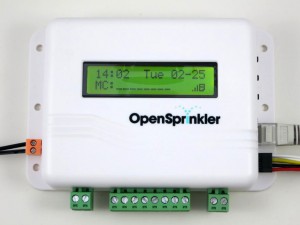
OpenSprinkler
Open-Source Internet-based Sprinkler / Irrigation Timer
Order
OpenSprinkler is available for purchase at Rayshobby Shop. Choose either a fully assembled product, or a DIY kit (including PCB, components, and enclosure to make your own OpenSprinkler).
Installation Tutorial
Firmware 2.1.0 Tutorial
Updates
- OpenSprinkler Firmware 2.1.0 is released.
- Our new website www.opensprinkler.com is now alive! Updated User Manual and API documentation are now hosted on the new site. Over time we will transition all OpenSprinkler related products and topics to the new site.
- OpenSprinkler DIY v2.2u is available.
- To receive updates, you can sign up to the Rayshobby RSS Feed, Google+, Twitter, or OpenSprinkler Email List, .
Overview
OpenSprinkler is an open-source web-based sprinkler controller / irrigation timer built upon open-source hardware and software. It works with standard 24V AC sprinkler valves commonly found in household watering and irrigation systems. You may be planning to buy a conventional sprinkler timer, but chances are that these systems provide a limited set of fixed functionality, and have no web scheduling and monitoring capability. These limitations are the main motivations for this open-source project.
This project is a collaboration between me and Chris Anderson (former editor-in-chief of the Wired Magazine).
What is OpenSprinkler?
OpenSprinkler is an open-source, web-based sprinkler / irrigation controller. Its a drop-in replacement for conventional sprinkler controllers that are not web connected. A web-connected controller like OpenSprinkler provides the following advantages:
- Intuitive User Interface (UI): no more messing with buttons and knobs, no more running to your garage to make a single sprinkler program change. Instead, use web browsers and mobile apps to set or change sprinkler programs. The web interface is much more intuitive than a small LCD screen.
- Remote Access: you can access your OpenSprinkler anywhere and at any time, whether you are at home, at office, or traveling away.
- Smart Control: OpenSprinkler can connect to the Internet and use real-time weather data (including historic and forecast data) to automatically make water time adjustments. It not only stops watering when it rains, but also scales water time up and down based on your local temperature and humidity.
Who is OpenSprinkler for?
OpenSprinkler is for homeowners as well as business owners including churches, farms, business parks, ranches, and sprinkler service professionals. Its applications include lawn and garden watering, plant irrigation, drip irrigation, hydroponics. Its low-cost and expandable: it can scale from a few zones for a modest house up to 48 for a large business installations. Our app lets you to access multiple OpenSprinklers together for unlimited coverage.
How is OpenSprinkler different from competitors?
Web-based sprinkler controller is not a new idea. OpenSprinkler differs from similar products on the market in the following aspects:
- OpenSprinklers has a built-in web interface and runs programs on its own. It does not rely on proprietary or PC-only software. The web interface works with any modern (including mobile) browser. Our mobile app is free and supports all major platforms.
- You can easily expand the number of stations. The cost is considerably cheaper than competing products on the market.
- The software offers a rich set of features, such as flexible program start times, graphical preview of program schedules and logging data, custom zone and program names, support to run zones either in sequence or parallel, water time down to one second. These features are rarely found in competing products.
- OpenSprinkler is shipped worldwide, and supports many different languages.
- OpenSprinkler is built on open-source hardware and software. Its design files are publicly available. There is a strong educational aspect of it. If you are a technical developer, you can easily customize and extend its functionality, both software and hardware. Because it’s open-source, you can feel free to build it, program it, modify it, or hack it! The design, including schematic, PCB, and parts list can be found in the Download section.
Buy OpenSprinkler from Rayshobby Shop.
Leave your comments and suggestions at the Rayshobby Forum. Thanks!
Contribute to the project through OpenSprinkler GitHub and Rayshobby Wiki.
Previous hardware release videos and notes are archived here.
